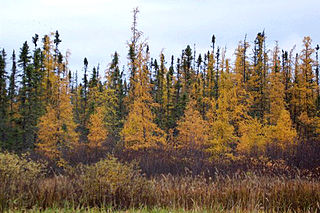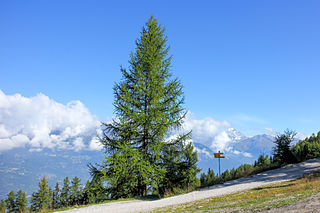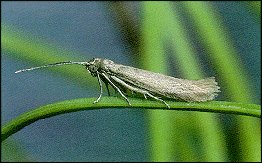Related Research Articles

Larches are deciduous conifers in the genus Larix, of the family Pinaceae. Growing from 20 to 45 metres tall, they are native to the cooler regions of the northern hemisphere, where they are found in lowland forests in the high latitudes, and high in mountains further south. Larches are among the dominant plants in the boreal forests of Siberia and Canada. Although they are conifers, larches are deciduous trees that lose their needles in the autumn.

Larix laricina, commonly known as the tamarack, hackmatack, eastern larch, black larch, red larch, or American larch, is a species of larch native to Canada, from eastern Yukon and Inuvik, Northwest Territories east to Newfoundland, and also south into the upper northeastern United States from Minnesota to Cranesville Swamp, West Virginia; there is also an isolated population in central Alaska. The word akemantak is an Algonquian name for the species and means "wood used for snowshoes".

Larix decidua, the European larch, is a species of larch native to the mountains of central Europe, in the Alps and Carpathian Mountains as well as the Pyrenees, with disjunct lowland populations in northern Poland and southern Lithuania. It is widely naturalized in Scandinavia. Its life span has been confirmed to be close to 1000 years but is more often around 200 years. It is claimed that one of the larches planted by the second Duke of Atholl at Dunkeld in 1738 is still standing.

The pine beauty is a moth of the family Noctuidae. It is a common species of pine woods in Europe. The distribution area extends from the west of Catalonia over southern France, central Italy, central Europe to western Siberia, the Caucasus and Asia Minor. In the north it extends to the Arctic Circle, in the south it is found on the northern Iberian Peninsula and southern Italy.

The International Larix Arboretum is a small arboretum of 1.2 acres (4,900 m2) dedicated to the scientific study of the larch (Larix) species. It is located within the Coram Experimental Forest, 30 yards SE of the Hungry Horse Ranger station at 10 Hungry Horse Drive Hungry Horse, Montana. The Arboretum is open to the public, without charge, during daylight hours from April to October.

The black arches or nun moth is a small Palaearctic moth. It is considered a forest pest.

Archips oporana, also known as the pine tortrix or spruce tortrix is a moth of the family Tortricidae, found in Asia and Europe. It was first described by Carl Linnaeus in 1758.

The Broom Moth(Ceramica pisi) is a moth of the family Noctuidae. It is found in all of Europe, East across the Palearctic to Siberia and the Russian Far East. In the north, it is found far beyond the Arctic Circle and in the south to northern Spain. In the Alps, it is found at heights of up to 2,000 metres.

Coleophora laricella, the western larch case-bearer, is a moth belonging to the family of case-bearing moths Coleophoridae. It is native to Central and Northern Europe, with its original food source being the European larch or Larix decidua. However, it was introduced to North America in the mid-19th century where it has gained a wide range and become an invasive defoliater of several species of the genus Larix, particularly the western larch Larix occidentalis and the tamarack larch Larix laricina.

The Zeiraphera griseana, the larch tortrix, is a moth of the family Tortricidae.

Cydia illutana is a small moth of the family Tortricidae. It is found from western and central Europe, north to Scandinavia and east to Russia (Siberia).

Upper and Lower Ogden Reservoirs are half a mile to the west of the village of Barley, in the Borough of Pendle, England. They supply drinking water to the town of Nelson.
Coleophora obducta is a moth of the family Coleophoridae. It is found in Japan and Russia (Baikal).
Argyresthia laricella, the larch shoot moth, is a moth of the family Yponomeutidae. The species was first described by William D. Kearfott in 1908. It is found in Canada, including north-western Ontario, Nova Scotia, south-eastern Manitoba, Saskatchewan, western Alberta and southern British Columbia.
References
- ↑ Brian Pitkin, Willem Ellis, Colin Plant and Rob Edmunds (April 2018). "Coleophora laricella (Hübner, 1817)". The Leaf and Stem Mines of British Flies and Other Insects.
{{cite web}}: CS1 maint: multiple names: authors list (link)